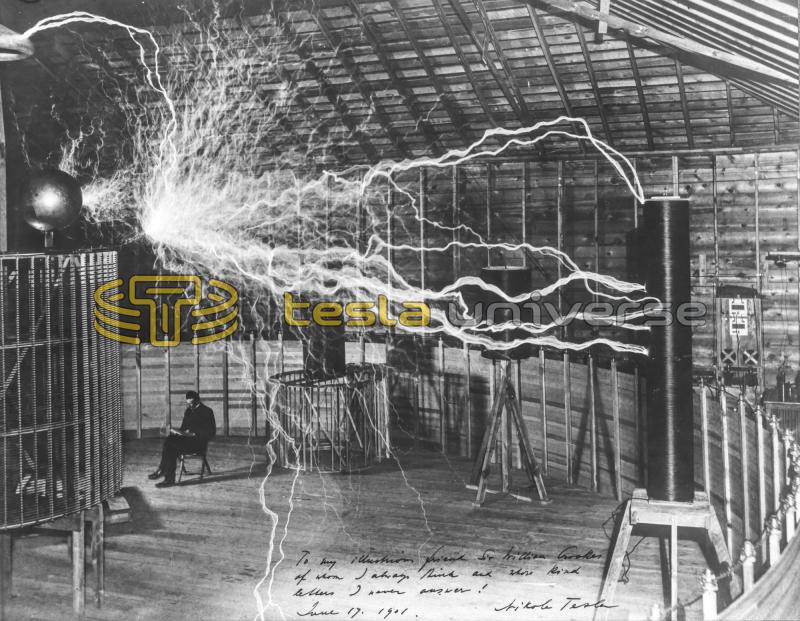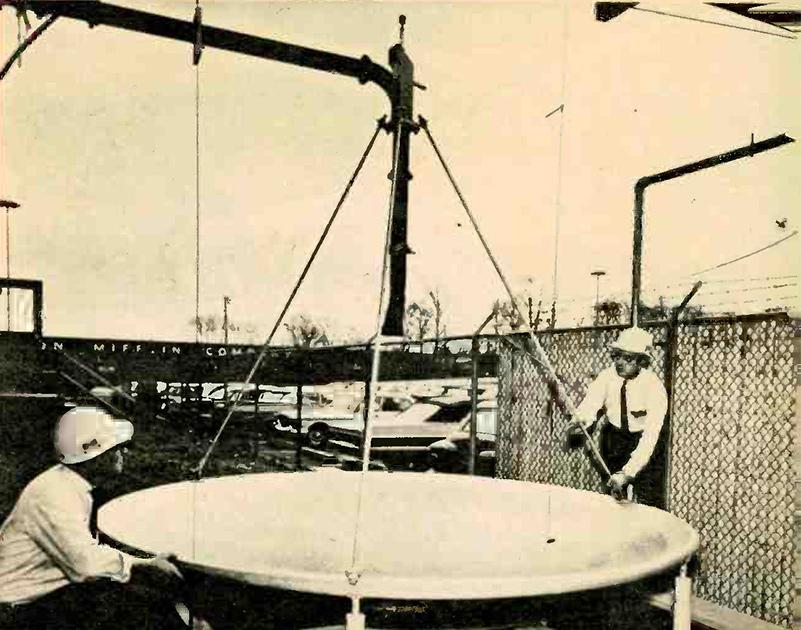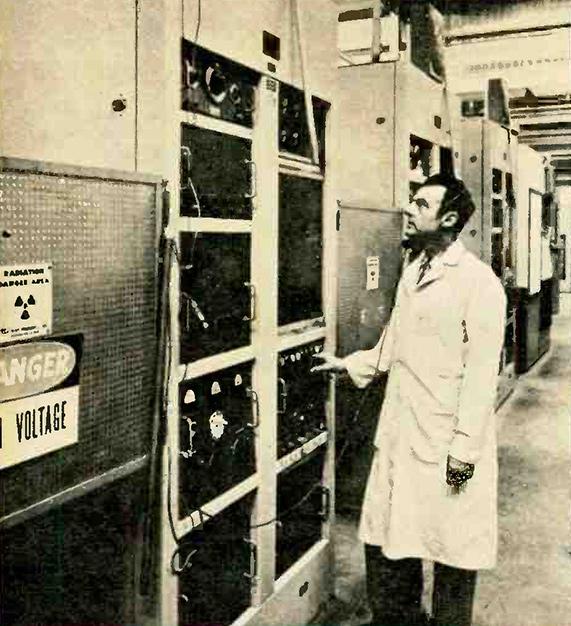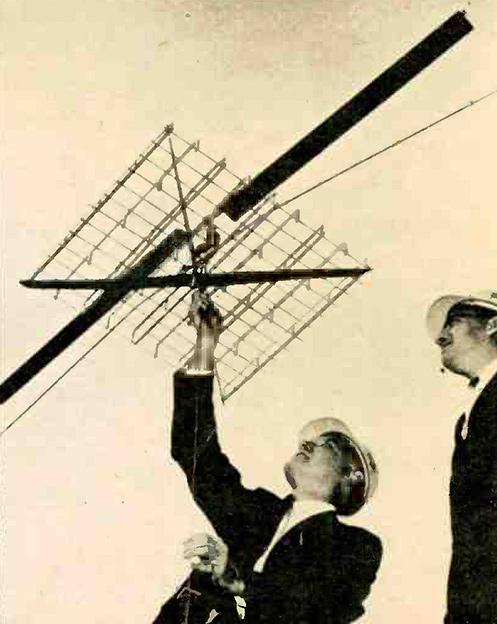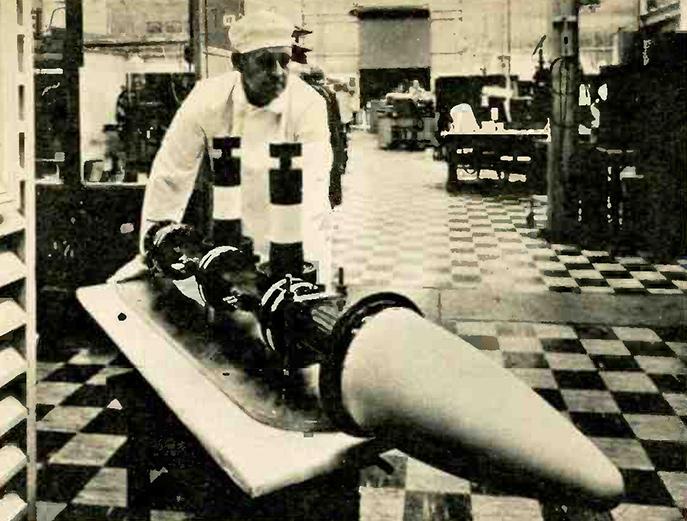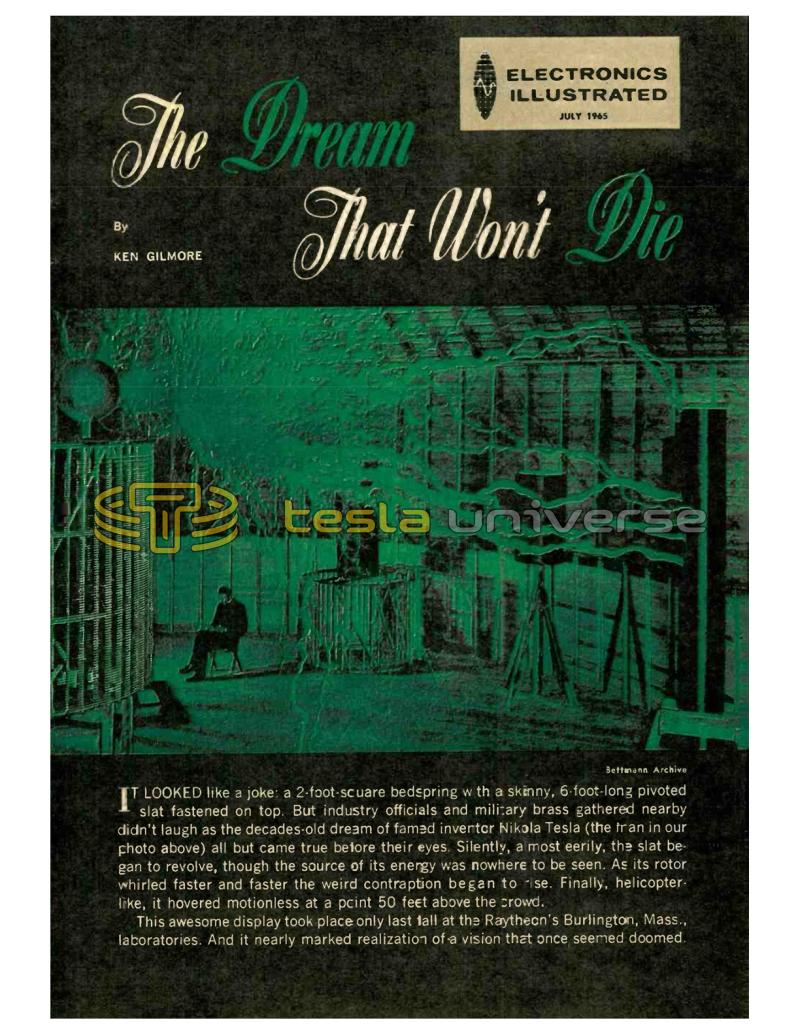
Nikola Tesla Articles
The Dream That Won't Die
It looked like a joke: a 2-foot-square bedspring with a skinny, 6-foot-long pivoted slat fastened on top. But industry officials and military brass gathered nearby didn't laugh as the decades-old dream of famed inventor Nikola Tesla (the tran in our photo above) all but came true before their eyes. Silently, a most eerily, the slat began to revolve, though the source of its energy was nowhere to be seen. As its rotor whirled faster and faster the weird contraption began to se. Finally, helicopter. like, it hovered motionless at a point 50 feet above the crowd.
This awesome display took place only last tall at the Raytheon's Burlington, Mass., laboratories. And it nearly marked realization of a vision that once seemed doomed.
For the model helicopter was powered not by the customary fuel-burning engine but by a silent, invisible beam of energy from the ground. Generated by a microwave transmitter, the energy was received by the bedspring-like antenna, converted to direct current, then used to drive the electric motor turning the rotor. With its fuel supplied continuously from the ground, the strange craft could go on flying indefinitely.
Raytheon's startling stunt - the first public showing of wireless power doing a useful job - opens up a whole new realm of exciting possibilities. Large unmanned helicopters, hovering continuously ten miles above the earth, would make dandy platforms for long-range surveillance radar. Other platforms could broadcast television programs over several states simultaneously. Or they could relay microwave signals half across the country in a single hop.
Another proposal would have balloons do a similar job. Small engines aboard-run by radio energy from the ground-would compensate for drift and keep the balloons on station. The magic beam also would power the electronic gear aboard. Even satellites ultimately might receive power to run electrical and electronic equipment directly from the earth.
For more than half a century, scientists have been trying to figure out how to transmit electric power without wires. First to tackle the problem seriously was the eccentric genius, Nikola Tesla. Now remembered chiefly for the type of coil that bears his name, Tesla once was smack in the middle of the power-transmission problem. In 1899 he got $30,000 from Col. John Jacob Astor, the wealthy owner of New York's Waldorf Astoria Hotel, to conduct a breathtaking experiment.
What Tesla proposed was to set up a gigantic sending set and radiate electrical energy all over the world. He would create standing waves of electricity that would cover the earth. People almost anywhere then could stick antennas up into this sea of invisible energy and tap off enough power to light lamps, drive motors or heat homes.
With the money from Col. Astor, Tesla went to Colorado Springs and built a strange 200-foot tower with a 3-foot copper ball. on top. At the bottom, he connected a huge Tesla coil, a special kind of transformer. The monster machine, similar in principle to ignition coils now used in automobiles, was designed to generate tremendous jolts of 150-kc RF power. (The photo on the first page of this article shows Tesla seated beneath just such a coil.)
When Tesla threw the switch, huge surges of energy ran up the tower. The inventor estimated that the potential on the ball reached 100 million volts. Spectacular bolts of man-made lightning forked viciously through the air and crashes of deafening thunder rolled across the countryside.
The show was spectacular but worthless. Engineers now know that the energy actually radiated probably was only a small percentage of the total involved. Worse yet, it was dissipated quickly in the earth's surface. And since the antenna spewed out its power in all directions, the amount available at any one location was extremely small.
Tesla, however, wasn't discouraged. He next convinced tycoon J.P. Morgan that his work had promise. Morgan, in turn, gave him another bundle of cash to carry on. This time, Tesla built a somewhat similar conJuly, 1965 traption on Long nd, about 60 miles east of New York City. The tower was wooden, 154 feet high. On top was a giant copper doughnut, 100 feet in diameter.
But Tesla never had a chance to test his second wireless-energy rig. He ran out of money before it was completed and couldn't find another backer. And when World War I came along, the government saw fit to tear his tower down. Since the structure could be seen for miles, the thinking was that it might give enemy ships an unmistakable landmark for plotting positions.
Next serious attempt to send power through thin air was somewhat more successful. In the early 1930's a Westinghouse researcher named H.V. Noble set up a couple of dipole antennas. Using a 100-mc signal. he managed to transfer several hundred watts of energy from one dipole to the other across his laboratory. But the amount of power transferred was too little and the distance was too short for the device to be practical. The setup was relegated to providing an eyecatching display in the Westinghouse exhibit at the 1933 World's Fair in Chicago.
Main problem during the early years of wireless power research was a sticky one. Engineers after Tesla knew that most of the power leaving the transmitting antenna would have to reach the receiving antenna if they were to transmit power through the air efficiently. This obviously meant that the energy would have to be focused into a narrow beam. But that ran squarely into the problem of wavelength.
By far the most effective beam-forming device, engineers knew, was the parabolic antenna now used on many radar and microwave devices. But the size of the dish depends on the wavelength of the signal to be focused. A high-frequency signal can use a small dish; a low-frequency, long-wavelength signal needs a big one. And that's where the trouble came in.
The only high-power signals electronic researchers knew how to generate back in the 1930's were low-frequency ones. Thing was, a dish to focus them would have to be miles in diameter and this obviously was impractical. The outlook for wireless power transmission was glum.
Prospects began to brighten, however, during World War II. The military services needed more-powerful high-frequency vacuum tubes for radar and scientists got to work on the promising magnetron and klystron NAIA tubes. After the war, work continued on these tubes and other types of high-power, high-frequency generators.
By 1958, Raytheon had developed what it called its Amplitron tube. Estimates were that this monster could be made to generate 400,000 watts of continuous power at a wavelength of 10 centimeters (3,000 mc), high enough to work beautifully in practical-size antennas. The company asked the Defense Department to back the design of a radio-powered helicopter it called RAMP, for Raytheon Airborne Microwave Platform. And military planners were impressed enough to give the company $90,000 to work out details.
Plan Raytheon came up with called for a strange monster that would hover 65,000 feet about 12 miles-above the earth. An array of antennas on the ground would beam 15,000 kw of microwave energy into the sky, focused like spotlight rays to converge at 65,000 feet. The helicopter, hovering in this sea of energy, would absorb 750 kw (the equivalent of about 1,000 horsepower) to drive the rotor and operate the electronic equipment. The micro-wave power received would be used to heat air or gas and drive a turbine engine. The engine, in turn, would propel the rotors and keep the vehicle flying.
When the pencil pushers really got to work, though, they found that the gas-turbine idea wasn't as hot as they had thought. Getting enough power up to the helicopter would be no problem. Catch was that there was no good way to scoop that power out of the air and convert it into usable form once it got to the helicopter. The first idea - turning it into heat and using that heat to drive a turbine was far too inefficient to be practical.
The answer came from a group of scientists at Purdue University. A professor of electrical engineering, E.M. Sabbagh, had set up an array of point-contact silicon diodes and sprayed them with microwave energy. Sabbagh found that the solid-state devices soaked up power from the air like sponges.
In the summer of 1963 Raytheon wired together a flock of the diodes, mounted an electric motor on top and hooked a helicopter rotor to the motor. The gadget flew under its own power - beamed from the ground - on July 1, 1964.
To be sure, the Raytheon helicopter is a relatively crude affair. Then, too, it's not completely free-flying but relies on a guide wire to hold it over the transmitting antenna. But automatic guidance controls that would apply correction when it begins to drift out of the beam could be built. (A similar system holds the beam-riding Nike missile on course.) And though the world's first radio-powered vehicle may be crude, it has proved its point: the old dream of wireless power transmission yet may come true.
One catch still is cost. Copper wire remains the cheapest way to transmit power; radio transmission is practical only where its great advantages outweigh the equally great expense. Raytheon has done some figuring and concluded that anyone wanting to operate a large microwave-powered flying platform at 10,000 feet for ten years would have to pay about $25 an hour. A system operating at 50,000 feet - and able to cover considerably more area - would run $50.
While that sounds like a lot of money, it's almost insignificant when compared with operating costs of the present airborne electronic sky stations it could replace. Radar patrol planes that cruise the Atlantic, for example, cost at least ten times as much per hour. So, too, do the educational TV broadcasting planes that currently hover over the Midwest.
Also worth noting is the fact that airborne electronic stations aren't the only place where microwave power transmission might come in handy. Earth satellites now struggle along with heavy batteries and unwieldy solar cells for electric power. They could save in both weight and complexity by tapping their power from ground-originated beams.
Back in the early days of satellites, one Pentagon official suggested that the problem of supplying electric power to earth-circling vehicles could be solved with an exceptionally long extension cord. He meant it as a joke. But now, science has turned the joke into reality. The long cord - wireless transmission - finally is here.
